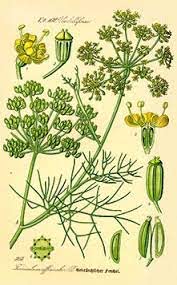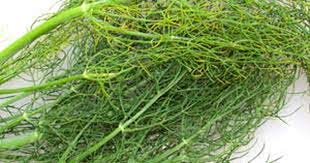Fennel's sweet dried-grass aroma earned it the Russian name 'foeniculum', deriving from the Latin foenum, meaning 'hay-like'. Native to the shores of the Mediterranean, fennel is a biennial or short-lived perennial herb growing up to 2m, with blue-green feathery leaves and umbels of golden-yellow flowers.

All parts of the plant are aromatic, although the highly prized essential oil derives from the ripened fruit or 'seed'.
There are two main varieties of fennel: bitter or common fennel (Foeniculum vulgare war. amara), and sweet or garden fennel (Foeniculum vulgare var. dulce). Sweet fennel is the preferred oil for use in aromatherapy, because of its more gentle nature. The plant has become naturalised in many parts of the world, including India, Japan and the US, and it mostly grows beside the sea. Many varieties are also cultivated worldwide, the main essential oil producers being Italy, Hungary, Bulgaria, Germany, France and India.
From Past to Present
In ancient Greece, fennel seeds were eaten by Olympic athletes i the belief that they would increase stamina and promote longevity. Fennel is mentioned in Anglo-Saxon recipes, and was traditionally eaten with salted fish during Lent. This combination fulfilled the dual function of helping to prevent flatulence and making the fish more digestible. By the 17th century, fennel had acquired a reputation as a slimming aid. Its seeds were chewed to relieve hunger pangs.
In many old herbalism books, fennel seed eye lotion is recommended as a remedy for failing eyesight. Herbal practitioners today do not credit the herb with quite such remarkable properties, but instead prescribe it in tea mixtures for ailments such as long-term constipation and diarrhoea, indigestion, flatulence (fennel extract is an ingredient in children's 'gripe water'), urinary disorders, coughs and bronchitis, and for its ability to increase the flow of milk in nursing mothers. Applied as an eye lotion or compress, cooled fennel-seed tea is helpful for minor eye complaints, such as irritation and morning puffiness.

In the kitchen, fresh fennel leaves are excellent for flavouring food, especially fish, while the thickened base of the related Florence fennel (Foeniculum azoricum) is boiled or braised like celery, and the young stalks eaten raw with salad.
The seeds may be chewed after meals to aid digestion and sweeten the breath.
Capturing the Essence
Sweet fennel essential oil is captured by steam distillation of the crushed seeds. Although usually colourless, the oil sometimes has a yellowish tint. The powerful aroma is reminiscent of aniseed - very sweet, but slightly earthy with a pepper-spice top note and camphoraceous undertone. The odour effect is generally perceived as warming and energising.
The first mention of fennel as an essential oil was in The Art of Distillation, a book written by Jeroma Brunschwig in 1500. In the 19th century, French doctors Cazin, Bozin and Bontemps classified fennel essential oil as a tonic, aperitif, galactagogue (stimulates milk flow in nursing mothers), emmanagogue (promotes menstruation) and carminative (alleviates flatulence). More recently, French aromatherapy pioneers Dr Laclerc and Dr Maury recorded cases of gout, rheumatism and kidney stones that had been successfully treated with internal doses of the essential oil.
Properties of the Oil
Like the herbal remedy, fennel oil's principle sphere of action is on the digestive system, However, it is important to point out that for long-term digestive problems, the essential oil would need to be taken internally by mouth of suppository. Such potentially risky methods are commonly employed by French aromatherapy doctors, but should never be undertaken by the home user. For milk indigestion, a few drops of fennel essential oil may be inhaled from a tissue at intervals until you experience relief. Alternatively, drink fennel-seed tea.
When used in a massage blend, sweet fennel has a reputation for helping to reduce cellulite, though for best results it should be combined with a detox iet (high in fruits, vegetables, wholegrains and water, low in caffeine and food additives) along with specialised massage treatments.

Anecdotal evidence among herbal practitioners and professional aromatherapists suggests that both the essential oil and the herbal remedy have a beneficial effect on the female reproductive system. This is thought to be due to the constituent anethole, a substance which is broadly similar in structure to the female hormone oestrogen.
However, rather than being a form of 'hormone replacement therapy', the effect of anethole in the body if thought to be primarily 'balancing' - heling to steady the hormonal fluctuations associated with PMS and the menopause. But fennel's traditional reputation as a substance capable of increasing milk production in nursing mothers is something of a mystery, as high levels of oestrogen in the body actually inhibit milk flow.
Nevertheless, historical accounts suggest that fennel is indeed a galactagogue. There may well be another substance in fennel (as yet unidentified) that accounts for this apparent anomaly. Certainly, there is much more to natural remedies than can be determined in the laboratory.
Other uses of the essential oil include that of a gargle or mouthwash for gum infections, and as a breath sweetener in toothpaste and other commercial dentifrices. Incorporated into an ointment base, or applied to a cold compress, fennel can help reduce bruising. For skin care, a tiny amount of fennel oil may be included in aromatherapy skin creams and lotions for dull or mature complexions.